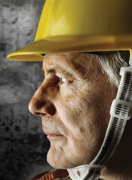
Interview with Helder Botelho

bh IN BRIEF
AOC supplies resins, gel coats, colourants and additives for composites and cast polymers. Its Canadian plant in Guelph employs 79 people and supplies resins to several industries, all hard hit by the recession. Looking long term, the company has not laid anyone off, and hours have been only slightly reduced overall. A new program, a strong internal communication strategy, and a generous benefits package are all building the base for success in the future. |
Helder Botelho is Plant Manager at AOC Resins and Coatings Company in Guelph, ON. He is also Past-Chair of the Industrial Accident Prevention Association, a unit of the Ontario Workplace Safety and Insurance Board.
1. Has your industry been hit hard by the recession? How have you worked through this hard time?
We supply resins to the marine industry, to housing, and to the automotive industry, so we’ve seen a significant drop in sales just like everyone else.
Because it takes time to train employees, we’ve been very cautious in terms of not doing anything rash. We’re a private company, so our owners are able to take a longer-term view, as opposed to the quarterly earnings view that public companies must take. We’ve not had any layoffs. We have reduced our hours somewhat, but we’ve not done anything beyond that. At the same time, we are very clear with our employees that we can’t make promises we might not be able to keep.
2. How important is that communication with employees?
Open and frequent communication with all employees is vital. I generally meet with each shift every quarter to explain the state of the business, where we’re going, how we’re doing, and give our employees a sense of the issues we’re facing. The communication needs to be open, respectful, and engaging.
3. Can you speak to your successes and challenges with disability management?
All of our short-term disability is self-insured. Our workforce is ageing and probably 25% have tenure of over 25 years. Many of our processes require going up stairs and while it may have been easy in your 30s, when you get to your 50s, wear and tear issues emerge.
Regardless of whether somebody is injured at work or not at work, the impact to the business is similar, if not the same. The company is losing an asset and a valuable employee for a period of time and costs are incurred because you have to back fill the position, train someone to do the job, and pay overtime to cover the job.
Recently, we implemented a participatory ergonomic program to help prevent or at least minimize the injuries that come through repetitive work, and improve our overall efficiency.
4. How do you ensure the products and chemicals you’re using aren’t harming employees?
We manufacture products that require a lot of hazardous chemicals so our medical surveillance program ensures our workers aren’t unduly exposed to them. All our employees meet with a company physician once a year, and a nurse comes to the plant every month.
Most of our hourly workforce is male, and men typically say ‘I’m not going to go to the doctor unless something’s really wrong’. The nurse and physician visits also help our employees identify what other health issues they might have. It’s something we’re very proud to offer employees.
5. What are your challenges with respect to your aging workforce?
The financial crisis means some people who would have considered taking early retirement may decide to work longer. The fact that mandatory retirement is no longer in place is a potential issue. It’s one thing to be working in an office environment in your 70s but if you’re working at a job requires you going up three flights of stairs, as ours does, what impact will that have?
6. How are you approaching the H1N1 virus? Do you have a pandemic plan?
We have a plant in Mexico that was impacted by H1N1. All our corporate sites have a very thorough human resources pandemic preparedness plan and a business continuity plan. The virus is a concern but we feel we’re prepared.
7. What role do senior executives have in promoting workplace health?
We have to walk the talk. We have to provide the resources that are needed. We can’t preach that we want a zero-incidence environment and not give managers and workers the tools to make it happen. We’re all about continuous improvement, not only in our products and processes, but also in health and safety.
8. How important is your benefits package in attracting and retaining employees?
I think it’s crucial. It speaks to the organization’s level of commitment to employees. We have a generous benefits package, retirement package, and profit sharing. They’re vital to having people work hard and still have some fun.
|
Categories: View from the Top
